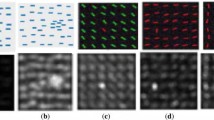Abstract
Visual attention is a mechanism to derive possible locations of objects or regions from natural scenes, and many studies have tried to simulate this mechanism to build saliency detection models, which would accelerate the course of many applications, such as object location, detection and recognition, image segmentation, retrieval and so on. Recently, researchers have tried building the detection models in transform domains. In this paper, a novel saliency detection model using shearlet transform is presented. Firstly, multi-scale feature maps are created. The feature maps built on scaling coefficients are used to generate potential salient regions, which is further used to update the feature maps generated on shearlet coefficients. As these feature maps represent the details of image in multi scale, based on them global and local contrast is calculated to form global and local saliency maps. That is the proposed model obtains the global saliency based on global probability density distribution, and measures the local saliency by calculating the entropy of local areas. By combining the local and global saliency maps, the final saliency maps are obtained. The work of this paper is absolutely a new try to detect saliency regions in shearlet domain, and experimental results demonstrate the saliency detection performance of the novel proposed model.



Similar content being viewed by others
References
Achanta R, Hemami S, Estrada F, Susstrunk S (2009) Frequency-tuned salient region detection. IEEE Conference on Computer Vision and Pattern Recognition
Candes E, Donoho D (2004) New tight frames of curvelets and optimal representations of objects with piecewise singularities. Commun Pure Appl Math 57(2):219–266
Donoho DL (1995) De-noising by soft-thresholding. IEEE Trans Inf Theory 41(3):613–627
Duncan K, Sarkar S (2012) Relational entropy-based saliency detection in images and videos. IEEE International Conference on Image Processing, Orlando, FL, pp. 1093–1096
Goferman S, Zelnik-Manor L, Technion AT (2012) Context-aware saliency detection. IEEE Trans Pattern Anal Mach Intell 34(10):1915–1926
Guo KH, Labate D (2007) Optimally sparse multidimensional representation using shearlet. SIAM J Math Anal 39(1):298–318
Guo CL, Zhang LM (2010) A novel multiresolution spatiotemporal saliency detection model and its applications in image and video compression. IEEE Trans Image Process 19(1):185–198
Imamoglu N, Lin WS, Fang YM (2013) A saliency detection model using low-level features based on wavelet transform. IEEE Trans Multimedia 15(1):96–105
Itti L (2000) Models of bottom-up and top-down visual attention. PhD thesis, California Institute of Technology
Itti L, Koch C, Niebur E (1998) A model of saliency-based visual attention for rapid scene analysis. IEEE Trans Pattern Anal Mach Intell 20(11):1254–1259
Kutyniok G, Labate D (2012) Shearlet: multiscale analysis for multivariate data. Birkhauser, New York, pp 22–59
Li ZQ, Fang T, Huo H (2010) A saliency model based on wavelet transform and visual attention. Sci China Inf Sci 53(4):738–751
Li J, Levine MD, An XJ, Xu X, He HG (2013) Visual saliency based on scale-space analysis in the frequency domain. IEEE Trans Pattern Anal Mach Intell 35(4):996–1010
Liu Q, Han T, Sun YT, Chu Z (2013) A two step salient objects extraction framework based on image segmentation and saliency detection. Multimedia Tools Appl 67(1):231–247
Liu T, Sun J, Zheng NN, Tang XO, Shum HY (2007) Learning to detect a salient object. IEEE Conference on Computer Vision and Pattern Recognition, pp. 1–8
Ma JW, Plonka G (2010) The curvelet transform. IEEE Signal Process Mag 27(2):118–133
Ngau CWH, Ang LM, Seng KP (2010) Bottom-up visual saliency map using wavelet transform domain. IEEE Int Conf Comput Sci Inf Technol Chengdu 1:692–695
Oakes M, Abhayaratne C (2012) Visual saliency estimation for video. International Workshop on Image Analysis for Multimedia Interactive Services, Dublin, pp. 1–4
Acknowledgments
This work was supported by the National Natural Science Foundation of China (61273210).
Author information
Authors and Affiliations
Corresponding author
Rights and permissions
About this article
Cite this article
Bao, L., Lu, J., Li, Y. et al. A saliency detection model using shearlet transform. Multimed Tools Appl 74, 4045–4058 (2015). https://doi.org/10.1007/s11042-014-2043-x
Received:
Revised:
Accepted:
Published:
Issue Date:
DOI: https://doi.org/10.1007/s11042-014-2043-x




